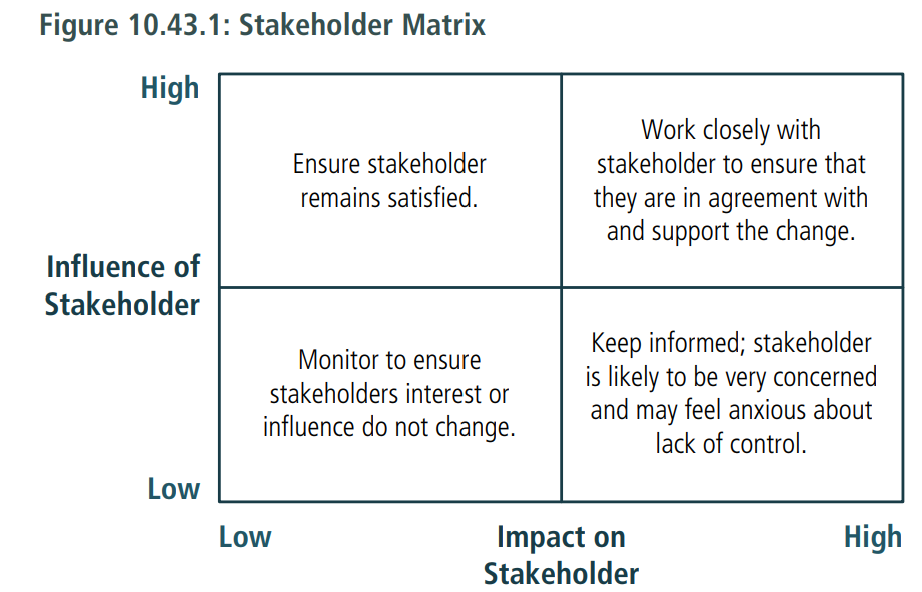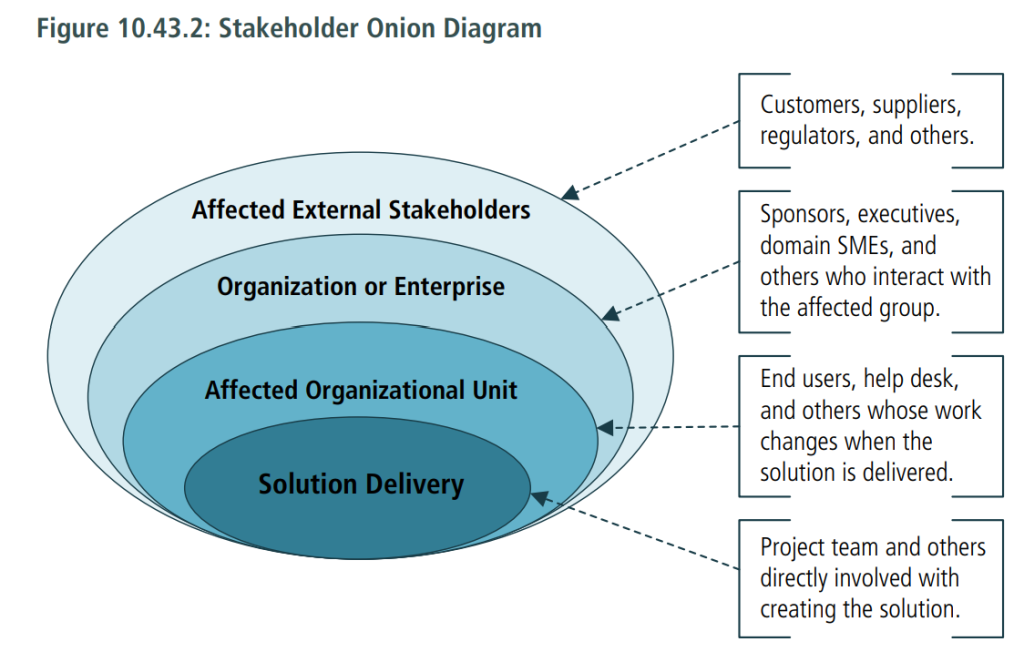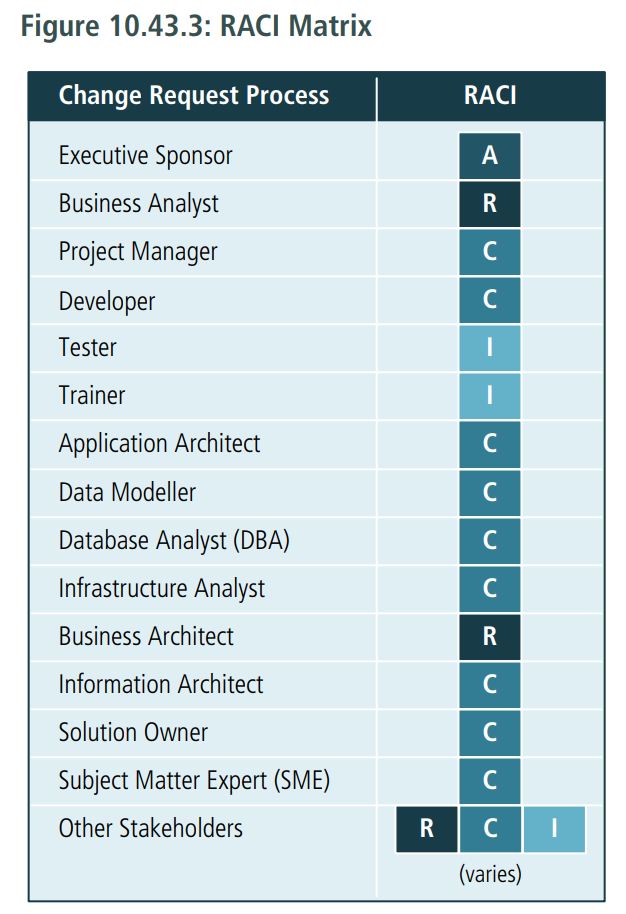10.43.1 Purpose
Stakeholder lists, maps, and personas assist the business analyst in analyzing stakeholders and their characteristics. This analysis is important in ensuring that the business analyst identifies all possible sources of requirements and that the stakeholder is fully understood so decisions made regarding stakeholder engagement, collaboration, and communication are the best choices for the stakeholder and for the success of the initiative.
10.43.2 Description
Stakeholder analysis involves identifying the stakeholders that may be affected by a proposed initiative or that share a common business need. Stakeholder analysis notes, considers, and analyzes the various characteristics of the identified stakeholders.
Common types of stakeholder characteristics that are worth identifying and analyzing include:
- level of authority within the domain of change and within the organization,
- attitudes toward or interest in the change being undertaken,
- attitudes toward the business analysis work and role, and
- level of decision-making authority.
For details on the work involved in conducting a thorough stakeholder analysis, see Plan Stakeholder Engagement (p. 31).
When analyzing stakeholders, business analysts utilize one or more techniques to draw out a list of stakeholders and analyze them. Stakeholder lists, maps, and personas are three tools that can be utilized when conducting this work.
10.43.3 Elements
.1 Stakeholder Lists
A business analyst may apply a number of techniques to generate a stakeholder list. Brainstorming and interviews are two common techniques that can be used.
The goal is to ensure a thorough list is produced because this list is central to both stakeholder analysis activities and the planning work the business analyst performs for elicitation, collaboration, and communication.
Stakeholder lists may become quite lengthy. As the analysis is conducted, the business analyst categorizes and adds structure to the list. It is important to have an exhaustive list to ensure that no important stakeholder or stakeholder group has been overlooked, which opens up the risk that requirements will be missed later on.
.2 Stakeholder Map
Stakeholder maps are diagrams that depict the relationship of stakeholders to the solution and to one another.
There are many forms of stakeholder maps, but two common ones include:
- Stakeholder Matrix: maps the level of stakeholder influence against the level of stakeholder interest.
- Onion Diagram: indicates how involved the stakeholders are with the solution, which stakeholders will directly interact with the solution or participate in a business process, which are part of the larger organization, and which are outside the organization.
The business analyst typically starts their stakeholder analysis by reviewing the proposed scope of the solution and then analyzing which groups will be impacted. At the start of this analysis, the business analyst may produce a stakeholder matrix to identify each stakeholder and their role as it pertains to the development of the requirements. Throughout a project, a stakeholder’s position on the matrix can change due to organizational, environmental, or requirement scope changes. Due to these potential changes, stakeholder analysis is considered iterative and reviewed frequently by the business analyst.

- High Influence/High Impact: the stakeholders are key players in the change effort. The business analyst should focus their efforts and engage this group regularly.
- High Influence/Low Impact: the stakeholders have needs that should be met. The business analyst should engage and consult with them, while also attempting to engage them and increase their level of interest with the change activity.
- Low Influence/High Impact: the stakeholders are supporters of and potential goodwill ambassadors for the change effort. The business analyst should engage this group for their input and show interest in their needs.
- Low Influence/Low Impact: the stakeholders can be kept informed using general communications. Additional engagement may move them into the goodwill ambassador quadrant, which can help the effort gain additional support.

.3 Responsibility (RACI) Matrix
Another popular stakeholder matrix is the responsibility (RACI) matrix. RACI stands for the four types of responsibility that a stakeholder may hold on the initiative: Responsible, Accountable, Consulted, and Informed. When completing a RACI matrix, it is important to ensure that all stakeholders or stakeholder groups have been identified. Further analysis is then conducted to assign the RACI designation in order to specify the level of responsibility expected from each stakeholder and/or group. It is common practice to define each term so that a consistent understanding of the assignment and associated roles are understood by any stakeholders utilizing the RACI matrix.
- Responsible (R): the persons who will be performing the work on the task.
- Accountable (A): the person who is ultimately held accountable for successful completion of the task and is the decision maker. Only one stakeholder receives this assignment.
- Consulted (C): the stakeholder or stakeholder group who will be asked to provide an opinion or information about the task. This assignment is often provided to the subject matter experts (SMEs).
- Informed (I): a stakeholder or stakeholder group that is kept up to date on the task and notified of its outcome. Informed is different from Consulted as with Informed the communication is one-direction (business analyst to stakeholder) and with Consulted the communication is two-way

.4 Personas
A persona is defined as a fictional character or archetype that exemplifies the way a typical user interacts with a product. Personas are helpful when there is a desire to understand the needs held by a group or class of users. Although the user groups are fictional, they are built to represent actual users. Research is conducted to understand the user group, and the personas are then created based upon knowledge rather than opinion. A number of elicitation techniques can be utilized to conduct this research. Interviews and surveys/questionnaires are two techniques commonly used to elicit this information. The persona is written in narrative form and focuses on providing insight into the goals of the group.
This allows the reader to see the story from the point of view of the stakeholder group. Personas help bring the user to life, which in turn makes the needs feel real to those who design and build solutions.
10.43.4 Usage Considerations
.1 Strengths
- Identifies the specific people who must be engaged in requirements elicitation activities.
- Helps the business analyst plan collaboration, communication, and facilitation activities to engage all stakeholder groups.
- Useful to understand changes in impacted groups over time.
.2 Limitations
- Business analysts who are continuously working with the same teams may not utilize the stakeholder analysis and management technique because they perceive change as minimal within their respective groups.
- Assessing information about a specific stakeholder representative, such as influence and interest, can be complicated and may feel politically risky.
